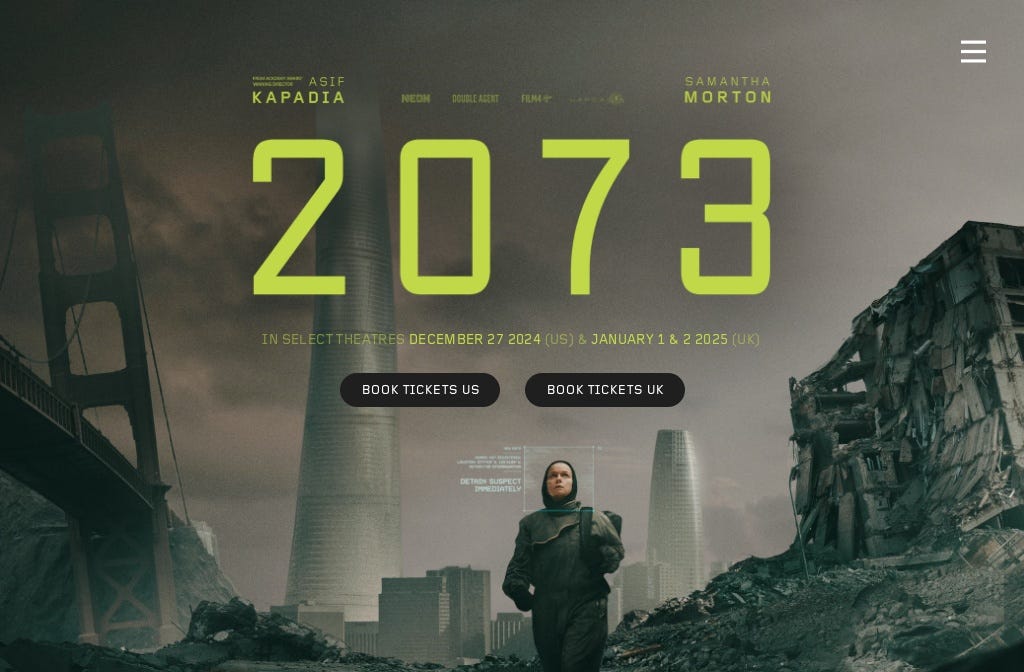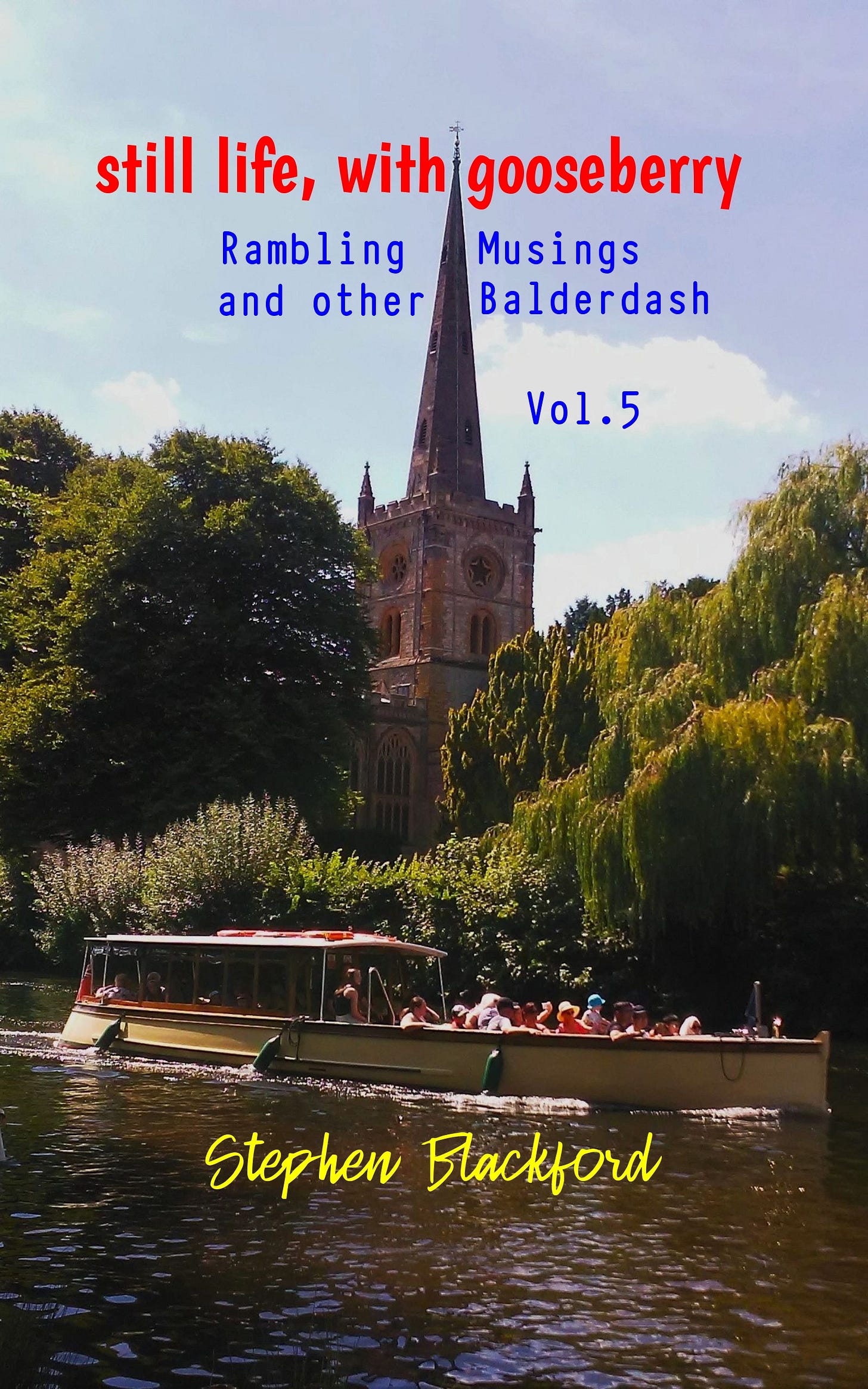2073 and Asif Kapadia is showing us all the dystopian end to a broken world
“The Party told you to reject the evidence of your eyes and ears. It was their final, most essential command”

The film begins with the first of a continuing series of narrations:
“I hope someone finds this
No-one said anything to stop them
It’s too late for me
I was alone
It may not be too late for you”
The final sentence in the narration is the last to fade from the screen as the first beautiful if ominous strains of orchestral strings sound as wild fires dominate the screen against the backdrop of a full moon and
“Year 2073”
and
“37 years after the event”
We now cut to the inside of a car being driven by a mainly unseen figure through the dense smoke and crackle of the wildfires before a further cut sees the devastation and destruction of an entire city reduced to rubble. As the sparse opening credits roll the scenes of decay and destruction continue as a wide crane shot depicts the remnants of two largely destroyed commercial satellite dishes before the human story is returned to and a mobile home adrift in a wide expanse of water before we see both the wider neighborhood similarly under water and a river of water flowing through and in between the high rises of a major city. A further cut now depicts a flowing wave of plastic and sewage before the polar opposite of a dried up town destroyed in the aftermath of a previous surge of high water.
The film now cuts to a smog filled, yellow hued city immediately named as “New San Francisco — Capital of the Americas”, one drone, then a fleet of them fill the dirty yellow coloured sky as we cut to the all seeing eye of total surveillance on ground level with police dressed as stormtroopers in full riot garb. After a quick cut to a robot dog patrolling the streets we see a POV camera shot from a person being physically manhandled by the police to the sounds of a CCTV camera whirring into dystopian action and human beings watching human beings, camera operators in a central command watching fellow human beings mistreating fellow human beings until one is “detained” and another cries out in pain as a police officer kneels on him. An immediate cut to a young boy at a check point is quickly cut away from and to the first piece of real life stock footage and three police officers holding down a fellow human being as one repugnant and violent police officer smashes the person’s head into the concrete before punching him in the head.
Nearly five minutes in and we now cut quickly from an ominous grey sky surrounding similarly grey high rise buildings to the brighter insides of a similarly brighter high rise and a see-through inside lift travelling to “Residential Levels” and with a portentous public address system inside announcing “Dear Passengers, people who behave disorderly in public areas will be punished according to regulations and their behaviour will be recorded. To avoid any negative record of personal credit, please follow the relevant regulations”. Accompanying the brighter high rise climbing into the sky is both a bright and full sun immediately over the building and the ominous tone to the orchestral strings of earlier is now replaced by a more upbeat and uplifting musical score. As the camera pans inside the building we are met with a futuristic and clean white coloured decor, opulent artwork hanging on the walls, a gaggle of people eating a meal at a large dining table surrounded with yet more artwork of the past and a look into their present future with robot dogs sitting at the side of a huge room. A further cut now depicts the inside of this high rise of the future as a high speed train roars through a vast domed enclosure containing a water fountain and green shrubbery before a descending camera takes us from the future past at the time of the event to a grey smog filled 2073 and 37 years later. The descending camera is deliberate as through the decayed and destroyed footings of what was once a high rise building we now drop into the bowels of the underground.
Through a cold, yellow hue we find “Ghost” (Samantha Morton) huddled beneath a mound of torn and dirty blankets in a cramped room, the minor details of her life are evident, as is the huge hole in the wall. Awakening slowly and fully dressed for the day, the narration now continues again:
“I can still remember my grandma. I used to help her out. My grandma used to say her memories were slipping through her fingers like sand. She said, we didn’t know it, but that was happening to all of us too. She said soon, there’d be no past, no history. She said it was the truth, and she didn’t care who heard. Then one day, they came for her, and she was gone. That stabbed to the heart of me, it silenced me. I never spoke again. I ran.
“I’m still running”.
During this narration the full extent of her living and sleeping space is laid bare, as are the small artworks on the walls and postcards and photos from the past. She winds up a handheld torch before leaving and we see the shattered, jagged remnants of the crumbling building she resides in before a quick cut demonstrates the lower levels of the building in a dirty yellow hue once more.
The narration continues:
“My life’s turned into one of those sci-fi comics I used to read. I live off grid. My place is in Shoes, on the lower ground. There are others here. Survivors. Renegades. There’s a tunnel up to Fragrances, where the old entrance was. It’s one of the six ways up to the surface”.
During this narration we follow the soon to be named “Ghost” through first the yellow hued remains of what was once a department store before the darkness of several crumbling tunnels seen only via her torch. We see several groups of fellow survivors huddled together, an older group barely visible but loudly audible, a younger group gossiping quietly amid candlelight.
The narration continues:
“I met this guy, Jack, dumpster diving one night. It was me who got him in here. He’s got these goofy, puppy dog eyes. He’s an AI. He listens and watches everything. You can’t trust anyone anymore. When you glean up on the surface, after curfew, you have to be quick. You avoid the dogs, you dodge the street militia”.
During this narration Ghost passes Jack in a corridor as she slowly advances toward the outside world. He tries to touch her which she avoids quickly before he announces he’s found another old photo she might like. The yellow hue of the outside world returns as with an overhead shot we see a dirty and decayed world and the shattered remains of a bus before we return to a POV from Ghost dumpster diving. She finds an almost perfectly new VR headset, a similarly almost new red baseball cap and a badly crumpled and water damaged book on Malcolm X. As police patrol the streets they pass a wall with the spray painted slogan “We never forgive, expect us”. Ghost hides from view as a man defying curfew is tasered by the police.
The narration continues:
“People thought the world would end. But the world goes on.
It’s us who will end.
And there’s the opening 12 minutes of 2073
More famously known for his incredible and highly recommended documentaries on the lives of Formula One racing driver Ayrton Senna, singer songwriter Amy Winehouse, Argentinian World Cup winner Diego Maradona and tennis legend Roger Federer, I was somewhat surprised to learn that 2073 is in fact Oscar winning Asif Kapadia’s seventh big screen cinematic release outside of the realm of capturing a fascinating real life inside a documentary, and yet here he combines both in an intriguing if more than a little hard to stomach imagining of if not the end of the world, certainly a long, long way towards its destruction. The picture painted is a grim one and of a catastrophic event in the year 2036 that here in the present day 37 years later sees the bare bones and remnants of humanity scavenging above ground for the meagre spoils to be shared below ground in a dank and dark underworld of pure stone age survival. Venturing above ground is only for the brave, foolhardy or desperate, as a bleak and destroyed natural world awaits them let alone a thuggish, brutal police state under the watchful gaze of the all seeing eye of a surveillance society already here in our 2025 reality for eyes willing to see and a mind ready for acceptance of that reality rather than that projected at them via their telescreens, sorry, television screens.
“The Party told you to reject the evidence of your eyes and ears. It was their final, most essential command” and whilst this quote from 1984 isn’t to be found within this cinematic merger of documentary and film, the theme of 1984 and every horrible dystopian film you care to name screams from the screen and long before the obvious denouement. From the opening 12 minutes as dissected above, the film quickly dissolves into the first of four elongated documentary segments packed full of real life stock footage as Kapadia continually plays with the timeline of the events of our lives. Whether it’s the rise of popularism and the supposed far right politics of Donald Trump, Nigel Farage or the brutal dictatorships within the Philippines or China, these latter two countries are covered in the second segment and after an introductory, almost mini-documentary before it on the effects of Brexit here in the UK and the Home Secretary of the time Priti Patel triumphantly exclaiming at a Conservative Party Conference that she will “end the free movement of people, once and for all”. Chilling stuff for those of us who remember these dystopian chapters of our lives and now here within this film for those of you who do not. Please note the loud clapping and cheers this pronouncement receives, but this is the thin end of a rather large and ugly wedge of authoritarianism shown here in all its dystopian glory.
From here and journalists in the Philippines and Myanmar being arrested and denounced as “enemies of the state” we have the central theme running through these documentary style segments of the continuing persecution of Muslims throughout the world, the appalling anti-human treatment of Uyghur Muslims in China who now number over one million in concentration camps (CONCENTRATION CAMPS) and a surveillance state in China which labels human beings as “Normal”, “Suspicious” or “Untrustworthy” and whilst these horrific labels aren’t applied openly around the rest of the world, the all seeing eye is horrifically displayed in Israel and Palestine, the UK and USA, Uganda and India. Another central theme of climate change bookends the documentary segments via the continuing destruction of the Amazonian Rainforests of Brazil and before it, a third segment on the rise of mega rich Billionaires such as Elon Musk, Jeff Bezos and Mark Zuckerberg and their tentacle connections into the ever quickening impact of AI. I’ve long contended that our collective human family isn’t wanted or needed any more and the rest of our diminishing worldwide family is now simply commodified into consumers of technology before an eventual merger with the machines that already largely control us. Here it’s laid bare, in spades, and via their own words and actions and the anti-human words and actions of so many more within their hyper real world of the unreality of the mega, mega rich.
Watching this film I had a continual mantra rolling around the tiny inside of my shattering mind of “well join up the dots then!”, but the director doesn’t and perhaps you won’t either. None of the horrific events of our lives depicted in the documentary segments happen in a vacuum. I’m a liberal lefty in a world of liberal lefties who AREN’T liberal lefties but who are drunk on the vacuous power afforded them by an Established order ecstatic they’re carrying out their orders willingly. Politics is, and has always been, the carnival of the bizarre and a ridiculous spectacle of two competing teams squabbling over who rules a One Party State where they always win and the rest of us lose. Politics became a sport a long, long time ago where you’re expected to cheer for your “team” regardless of how anti-human and appalling they are and boo and barrack the opposition for their failings. There’s a change of the political guard but the Establishment always gets in. I won’t make any friends here by saying this but this goes way deeper than surface politics or the cheering for some cheapjack shithead in an expensive suit who proudly proclaims they’re going to stop the free movement of fellow human beings. Join the dots. There’s an anti-human agenda throughout society, headed by anti-humans who are anything but human and I dare say many would fail a Turing Test. But those truths sting, as does the realisation that we’re already living in a 1984 world of surveillance and the net is closing fast and in line with China. Where there should be outrage is apathy, unless of course you’re ordered to cheer on a politician wearing a colourful rosette and a smile beneath darkly dead eyes. Where’s the outrage about the containment of millions of fellow human beings in concentration camps, the genocide in Palestine, the harassment of journalists as enemies of the state, the total surveillance society or the chasm between the almighty rich and the downtrodden, looked down upon cogs in an algorithmic wheel of the working class poor? There is no outrage but acceptance, thankful we’re not of an ethnic origin deemed surplus to requirements and only fit for concentration camps and the ultimate destruction of their faith and way of life, thankful for the bread and circus of vacuous politics, a dubious town of tinsel and the sporting combat that was supposed to supplant that of warfare between nations. But that continues, cheered on as Orwell’s forever war plays out on a telescreen primed and ready full of Establishment fear and propaganda for the dumbed down, numbed down masses encouraged to consume and give their power away to a singular, wraith like figure in an expensive suit who vows that change is coming, there’s hope for the future, and all the while the machines are learning and watching our every move, our every human interaction, our wants and human desires drained into a blob of conformity.
Bar coded Humans. In a QR Coded World.
Well that was some tangent we found ourselves on wasn’t it! Where were we? Oh yes, the film. Contributors to the documentary segments such as Silkie Carlo, George Monbiot and Anne Applebaum (among many, many more) easily outnumber the cast of just three in this docudrama based on the 1962 featurette La Jetée by Chris Marker. Samantha Morton excels as usual within a non-speaking role and in a performance I saw echoes from an entirely different role in Lynne Ramsay’s Morvern Callar in 2002. Only echoes. A quiet desperation perhaps? I also found echoes in the superb musical score from Antonio Pinto of the Kronos Quartet in Darren Aronofsky’s similarly difficult to watch Requiem for a Dream.
Essential, if darkly grim viewing.
Highly recommended.
Thanks for reading. Well, if you’ve reached this far the world clearly hasn’t ended yet and whilst you’re here, can I brag about my latest self-published books in late December 2024 and early January 2025?
Give you something to read around the campfire before curfew!
Peace.
"still life, with gooseberry" - link to Amazon
"Rasputin and Raspberry Jam" - link to Amazon






